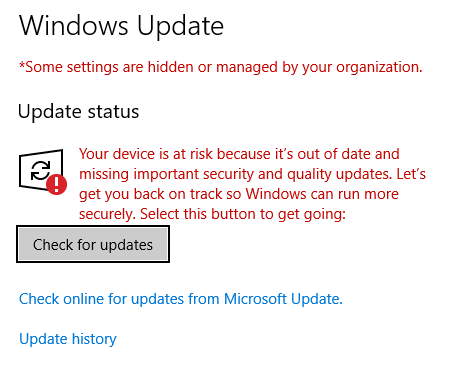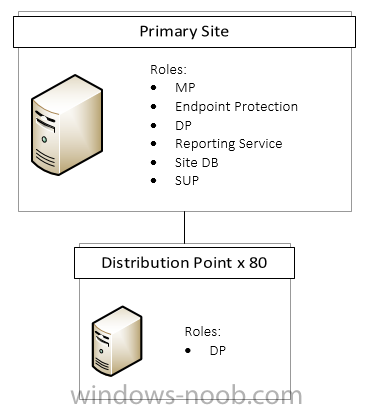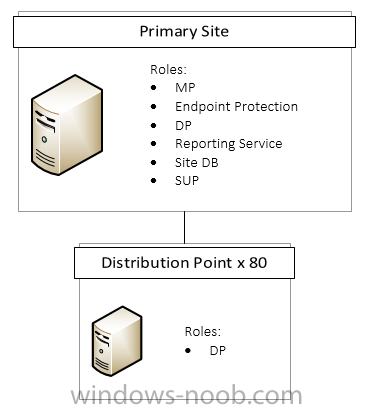
teamfox201
-
Posts
90 -
Joined
-
Last visited
-
Days Won
1
Posts posted by teamfox201
-
-
-
Started BitLocker POC about a month ago. Initially had MBAM in the design but after learning it was going away I decided to stick with keys in AD. We are not currently using Azure or Intune.
-
I have been looking at the Config Manager Antivirus Exclusion list (https://blogs.technet.microsoft.com/systemcenterpfe/2017/05/24/configuration-manager-current-branch-antivirus-update/) and was wondering how others have this organized.
I am looking at having at least 2 policies (Workstation and Servers) but for servers, are you adding all the exclusions under one policy or making it neater in the console and making a new exclusion policy for SQL, IIS, ConfigMgr, etc.?
-
Good find!!
Your question sparked curiosity about our environment but we still have Powershell 2.0 on Windows 7 systems.
-
I think i found my answer, it is a "feature" in 1802 that will get expanded on in other updates...
This is fixed in the just shipped #SCCM 1802 release. For both Primary User, and Logged on user. We still will improve a couple things:
1) it is only in devices views; and we will add it in more views (collections, etc.) -
4 hours ago, JBC said:
Has anyone developed an application that will run the Get-SpeculationControl script from Microsoft and return useful results? I have a few ideas on how to do it.
I want to develop a script that checks if the computer is compliant and write a registry key which I can check for success/failure.
I am not sure how to design this since I would have to install the module on each computer as part of the application. 30% of my computers are offline most of the time which is why I want to do this with SCCM so it runs as they connect to the network.
If someone has already developed something that works I'd like to know how it was done.
To be fair, I have not tested this method but I do not see a reason it would not work as long as the return codes are properly returned and captured during deployment.
I would use the application developed by Steve Gibson https://www.grc.com/inspectre.htm . Don't let the basic website fool you, he is reputable.
Package that up in SCCM with the "probe" command , and based on the exit code returned to SCCM you should get a pretty good picture of which systems are vulnerable.
I just noticed in release #4 , he gives you sample scripts you can use: https://www.grc.com/inspectre/InSpectre-Probe-Samples.zip
Release #4 — Silent System Probe Option:
When InSpectre is launched with the string “probe” in its command line, its Windows user interface will be suppressed and InSpectre will act like a command-line utility. It will assess its hosting system's status, then immediately terminate itself returning a decimal exitcode which encodes the eight “trouble bits” shown below, which itemizes any trouble. Therefore, for example, an exitcode of zero (0) is returned only by a fully secure system.
Decimal
ValueTrouble Itemization 1 OS is not aware of the Meltdown vulnerability 2 OS is not aware of the Spectre vulnerability 4 The system is vulnerable to Meltdown 8 The system is vulnerable to Spectre 16 CPU does not support Spectre (microcode not updated) 32 CPU does not support low-overhead Meltdown protection 64 Meltdown protection disabled by registry setting 128 Spectre protection disabled by registry setting -
Not sure if this is a bug in SCCM 1802 or if it is a new "feature" but I am seeing it in the production environment and also my lab. Anyone else notice this and any idea what may be going on?
When looking at the "Devices" collection, all the columns for Primary User(s) , Last Logged on User, and Last Logon Timestamp show data correctly.
When I create a new collection, for example a Windows 10 Workstations and add Primary User(s) , Last Logged on User, and Last Logon Timestamp... all the columns are blank, even if "Devices" collection has data in them.
-
On 5/31/2018 at 7:55 PM, Arti said:
thanks but its not possible. I need my direct access clients to receive software package deployments via primary site DP but MS security updates via Microsoft. Therefore i need to configure the boundary to primary site server DP/MP
Looks like this may be available for you soon. Check out the "Deploy software updates without content" section in the link below.
-
On 5/22/2018 at 3:33 AM, jfdensmore said:
Hello everyone. I have a question about the functionality of these buttons. So I want SCCM to handle all Windows and Defender Updates and I have SCCM CB 1802 distributing Windows and Defender updates. But when i click the Check for updates button in either locations on a windows 10 client all i ever see is either the image below, or an "Updates are up to date".
My question is.... are these buttons useless while using Sccm now? Also how can i confirm my devices are actually pulling End point updates from SCCM?And one last question, if i have sccm distributing Updates, is it necessary for me to allow the "Check online for updates from Microsoft update." link to remain active or is it smart to eliminate that.
-
Are these buttons useless while using Sccm now.
- Check for updates is not entirely useless with SCCM, it forces Windows to check your local WSUS server for updates.
-
How can i confirm my devices are actually pulling End point updates from SCCM.
- Definitely get familiar with the SCCM Client log files: https://docs.microsoft.com/en-us/sccm/core/plan-design/hierarchy/log-files#BKMK_ClientLogs
-
You can look through these log files:
- C:\Windows\CCM\Logs\DataTransferService.log - see where its pulling the AM_Delta_Patch_x.xxx.xxx.x.exe from.
- C:\Windows\WindowsUpdate.log - Follow what the log says on Windows 10 to actually get the log content.
- C:\Windows\Temp\MpCmdRun.log
-
Is it necessary for me to allow the "Check online for updates from Microsoft update." link to remain active
- No it is not necessary and you can turn it off with GPO (see Do not connect to any Windows Update Internet locations in the link below)
- https://docs.microsoft.com/en-us/windows/deployment/update/waas-wu-settings
-
Are these buttons useless while using Sccm now.
-
On 5/24/2018 at 9:17 PM, Arti said:
how direct access users can download updates from microsoft instead of MP?
when you deploy the software update group, it downloads the updates to the MP. Therefor "If software updates are not available on preferred distribution point or remote distribution point, download content from Microsoft Updates" will always be available and will never download from Microsoft Updates. Correct?
I would imagine if you do not associate the Direct Access IP range/subnet (boundary) with any Boundary Group/Distribution Point, then the clients will not know where to pull data from and reach out to Microsoft.
-
If you have verified the systems are no longer around and do not need the client installed, I would right click the computer name and look at properties. Then look at the value for agent name. If it says AD System Discovery (and those systems are no longer around) then delete the record from Active Directory. If the agent name says something else then figure out how to clean up that discovery method so obsolete systems do not get pulled back in during every sync.
https://docs.microsoft.com/en-us/sccm/core/servers/deploy/configure/about-discovery-methods
-
Hello,
Looking for some assistance on getting large packages (task sequence, windows updates, etc) to distribution points with slow WAN speed.
We have about 80 sites averaging 1.5 - 3 mbps back to HQ and we cannot impact their network during the day with SCCM distributions. Currently have the rate limit on those DP's configured to 50% during business hours. With driver updates and Microsoft Monthly Rollup patch bundles growing large in size, it takes forever to get the packages to all the distribution points even over the weekend.
For example:
Windows 10 patches for 2017 is reporting to be 3.5 GB and that's just one package.
Looking for tips and tricks from what others are doing to overcome these bandwidth limitations without impacting their slow sites.
-
Hello,I am sorry for the double post (SCCM 1610 Cloud Proxy Service), I couldn't figure out how to edit/delete the title but i wanted to have the correct words in my post.I am looking for some clarification on setting up the Cloud Management Gateway in SCCM. We have a primary site (managing about 6000 clients) and about 80 distribution points at small offices with 3mbps or less WAN speed. We are looking into managing remote machines that are not in the office and the Cloud Management Gateway looks pretty promising.The question I have is, do we need to set up another primary or just another DP (like the small office config) but with the MP, DP and SUP roles using HTTPS? Trying to avoid having to set up another primary and then adding a CAS if possible.
-
Hello,
I am looking for some clarification on setting up the Cloud Management Gateway in SCCM. We have a primary site (managing about 6000 clients) and about 80 distribution points at small offices with 3mbps or less WAN speed. We are looking into managing remote machines that are not in the office and the Cloud Management Gateway looks pretty promising.
The question I have is, do we need to set up another primary or just another DP (like the small office config) but with the MP, DP and SUP roles using HTTPS? Trying to avoid having to set up another primary and then adding a CAS if possible.
-
Hello,
I am trying to deploy Windows 10 1511 to Dell hardware and I am seeing a weird square/rectangle instead of the spinning circles towards the end of the task sequence.
During the task sequence , I am pre-provisioning BitLocker, injecting drivers for the specific model, installing a handful of applications and MBAM 2.5 ( Microsoft BitLocker Administration and Monitoring ) , running Windows Updates and Enabling BitLocker .
I have attached an image of the loading screen we are seeing. I am not sure if this is why after the task sequence enables BitLocker, BitLocker goes into recovery mode after each reboot and even if you suspend and resume protection.
Any help with this is appreciated.
-
"Windows could not configure one or more system components."
Have you installed the KMDF drivers?
-
Hello,
We have a call center (bread and butter of business) with about 1000 users. What would be the best way to scatter patching to this group in case we have a bad patch (management concern) so we don't take out the whole department.
Thanks!
-
I think it creates the folder on the drive with the most space. That computer must have multiple drives or partitions where E: is bigger than C:
-
I've had similar issues where the only way to fix it was to create a duplicate and make changes in the duplicate then use that task sequence.
-
You can use a hta script with a drop down with all your OUs and even prompt for the computer name at that time.
Sample script that you can edit:
http://gallery.technet.microsoft.com/SCCM-OSD-Menu-HTA-ab5565ec
-
Hi Markus,
I had the same problem where it removed some assemblies during distribution. I just ran these steps on the boot.wim file on my bootable USB to test if what I want to do will even work before I troubleshoot this further.
-
Never too late, I could still use this. I will give it a try today . Thanks for the information!
-
See if this provides you a starting point: http://support.microsoft.com/kb/2018583
-
I was thinking more along these lines.
Make sure the student account is part of the built in users group (BUILTIN_USERS S-1-5-32-545) which does not change SIDS, then apply the LGPO to that group.






SCCM 1810 Application Approval Request Emails
in System Center Configuration Manager (Current Branch)
Posted
I'm trying to figure this out too.